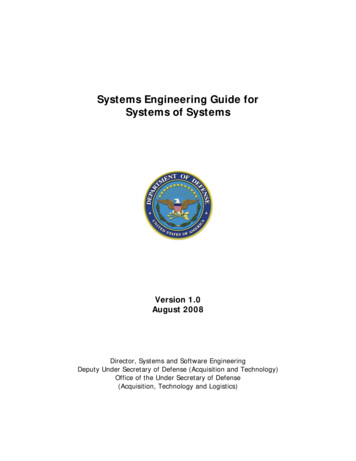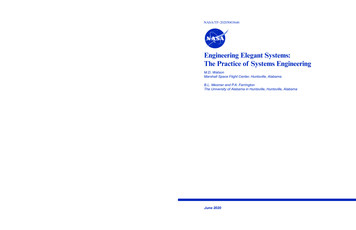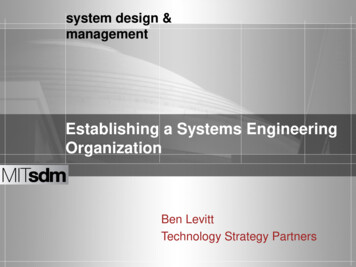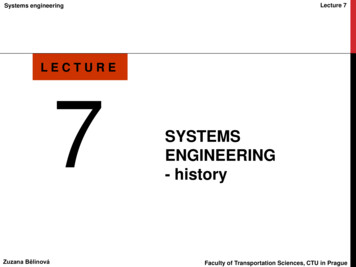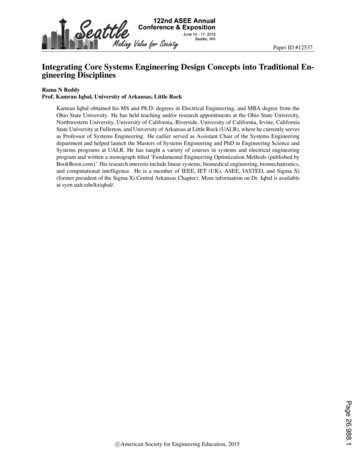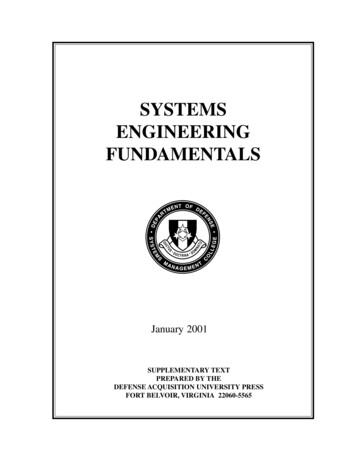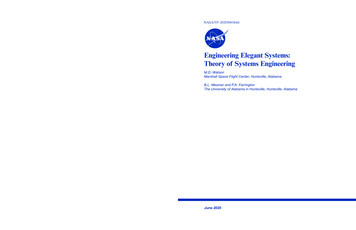
Transcription
National Aeronautics andSpace AdministrationIS02George C. Marshall Space Flight CenterHuntsville, Alabama 35812NASA/TP–20205003644Engineering Elegant Systems:Theory of Systems EngineeringM.D. WatsonMarshall Space Flight Center, Huntsville, AlabamaB.L. Mesmer and P.A. FarringtonThe University of Alabama in Huntsville, Huntsville, AlabamaJune 2020
The NASA STI Program in ProfileSince its founding, NASA has been dedicated to theadvancement of aeronautics and space science. TheNASA Scientific and Technical Information (STI)Program Office plays a key part in helping NASAmaintain this important role.The NASA STI Program Office is operated byLangley Research Center, the lead center forNASA’s scientific and technical information. TheNASA STI Program Office provides access tothe NASA STI Database, the largest collection ofaeronautical and space science STI in the world.The Program Office is also NASA’s institutionalmechanism for disseminating the results of itsresearch and development activities. These resultsare published by NASA in the NASA STI ReportSeries, which includes the following report types: TECHNICAL PUBLICATION. Reports ofcompleted research or a major significantphase of research that present the results ofNASA programs and include extensive dataor theoretical analysis. Includes compilationsof significant scientific and technical dataand information deemed to be of continuingreference value. NASA’s counterpart of peerreviewed formal professional papers but has lessstringent limitations on manuscript length andextent of graphic presentations. TECHNICAL MEMORANDUM. Scientificand technical findings that are preliminary or ofspecialized interest, e.g., quick release reports,working papers, and bibliographies that containminimal annotation. Does not contain extensiveanalysis. CONTRACTOR REPORT. Scientific andtechnical findings by NASA-sponsoredcontractors and grantees. CONFERENCE PUBLICATION. Collectedpapers from scientific and technical conferences,symposia, seminars, or other meetings sponsoredor cosponsored by NASA. SPECIAL PUBLICATION. Scientific, technical,or historical information from NASA programs,projects, and mission, often concerned withsubjects having substantial public interest. TECHNICAL TRANSLATION.English-language translations of foreignscientific and technical material pertinent toNASA’s mission.Specialized services that complement the STIProgram Office’s diverse offerings include creatingcustom thesauri, building customized databases,organizing and publishing research results evenproviding videos.For more information about the NASA STI ProgramOffice, see the following: Access the NASA STI program home page at http://www.sti.nasa.gov E-mail your question via the Internet to help@sti.nasa.gov Phone the NASA STI Help Desk at757 –864–9658 Write to:NASA STI Information DeskMail Stop 148NASA Langley Research CenterHampton, VA 23681–2199, USA
NASA/TP–20205003644Engineering Elegant Systems:Theory of Systems EngineeringM.D. WatsonMarshall Space Flight Center, Huntsville, AlabamaB.L. Mesmer and P.A. FarringtonThe University of Alabama in Huntsville, Huntsville, AlabamaNational Aeronautics andSpace AdministrationMarshall Space Flight Center Huntsville, Alabama 35812June 2020i
AcknowledgmentsThe progress made in defining elegant, product-focused systems engineering is due to the work by the membersof the Systems Engineering Research Consortium. These researchers represent excellence in their field and have impressedwith their knowledge, intuition, and research. It is a pleasure working with and discussing with them the challengingquestions raised in the discipline of systems engineering. Phil Farrington, Paul Collopy, and Bryan Mesmer at TheUniversity of Alabama in Huntsville have been outstanding leaders for the university consortium. Present and pastmembers are:Michael D. Griffin, Ph.D., former NASA AdministratorNorth Carolina State University: Jon Stallings, Ph.DAir Force Research Laboratory—Wright Patterson,Multidisciplinary Science and Technology Center:Jose A. Camberos, Ph.D., Kirk L. Yerkes, Ph.D.Alabama A&M University: Emeka Dunu, Ph.D.Oregon State University: Irem Tumer, Ph.D.,Christopher Hoyle, Ph.D.George Mason University: John S. Gero, Ph.D.SpaceWorks Enterprises, Inc.: John Olds, Ph.D.George Washington University: Zoe Szajnfarber, Ph.D.,Samantha Marquart Brainard, Ph.D.Stevens Institute of Technology: Khaldoun KhashanahTexas A&M University: Richard Malak, Ph.D., Robert PriceIowa State University: Christina L. Bloebaum, Ph.D.,Michael C. Dorneich, Ph.D.Tri-Vector Corporation: Joey Shelton, Ph.D.JBS Solutions: Sherrie Nash, Ph.D., Robert S. Ryan,Kenny Mitchell, Jeff DownsThe University of Alabama in Huntsville: Phillip A.Farrington, Ph.D., Dawn R. Utley, Ph.D., Laird Burns,Ph.D., Paul Collopy, Ph.D., Bryan Mesmer, Ph.D.,P. J. Benfield, Ph.D., Wes Colley, Ph.D., Jeff Little, Ph.D.,George J. Nelson, Ph.D., Dale Thomas, Ph.D.,Sean Owens, Casey EatonMultidisciplinary Software Systems Research Corporation(MSSRC): Larry LambeMassachusetts Institute of Technology: Maria C. Yang, Ph.D.Missouri University of Science & Technology:David Riggins, Ph.D.The University of Arkansas: David C. Jensen, Ph.D.NASA Johnson Space Center: Gordon A. Vos, Ph.D.The University of Bergen: Erika PalmerNASA Langley Research Center: Peter A. Parker, Ph.D.,Ken Toro, Anna R. McGowan, Ph.D., William Cirillo,Marie Ivanco, Kevin D. EarleThe University of Colorado – Colorado Springs:Stephen B. Johnson, Ph.D.Doty Consulting Services: John Doty, Ph.D.NASA Marshall Space Flight Center: James G. Andrews,Jeri G. Eckley, Jennifer S. StevensThe University of Michigan: Panos Y. Papalambros, Ph.D.,Melissa Greene, Ph.D., Arianne Collopy, Ph.D.NASA Marshall Space Flight Center, Aetos Corporation:Michael L. CulverThe University of Texas, Arlington: Paul J. Componation,Ph.D., Susan Ferreira, Ph.D.TRADEMARKSTrade names and trademarks are used in this report for identification only. This usage does not constitute an officialendorsement, either expressed or implied, by the National Aeronautics and Space Administration.Available from:NASA STI Information DeskMail Stop 148NASA Langley Research CenterHampton, VA 23681–2199, USA757–864–9658This report is also available in electronic form at http://www.sti.nasa.gov ii
PREFACEThe NASA Systems Engineering Research Consortium was founded to investigate the engineering and mathematical basis of systems engineering. The Consortium brought together sometremendous systems engineering researchers from across the country to contribute their investigativework to an integrated body of knowledge. I have had the great privilege of working with the researchers, discussing their research, and bringing together their tremendous intellectual understandings todefine the basis of systems engineering.In the summer of 2010, as NASA was transitioning from the cancellation of the Constellation program to the Exploration Systems Framework, NASA Marshall Space Flight Center (MSFC)Engineering Directorate Associate Director, Garry Lyles, asked my thoughts on systems engineering. He was looking for a way to advance the discipline. After discussing some of the characteristicsof a systems engineer stated by the Jet Propulsion Laboratory/Gentry Lee, Garry asked that I speakwith former NASA Administrator Mike Griffin, who was serving as The University of Alabama inHuntsville (UAH) Eminent Scholar and Professor of Mechanical and Aerospace Engineering. Theconversation with Mike revealed several common ideas on the challenges for systems engineeringand the path systems engineering needed to take to advance as a discipline. We agreed to establisha research effort to consider the advancement of systems engineering and provide an engineering andmathematical basis for the emerging discipline. The MSFC Space Launch System (SLS) programsupported the establishment of the Consortium, and a list of researchers who had a strong focus onthe engineering basis of systems engineering were asked to participate in early research efforts.Initial efforts in the consortium were an exploration of different engineering approaches forsystems engineering. Phillip Farrington became the principle investigator (PI) when Mike left UAHand became Chief Executive Officer of Schaffer Corporation. The four characteristics of an elegantsystem defined in Mike’s paper, ‘How do we fix System Engineering?’ guided the effort. These characteristics provided some focus, but a framework needed to bring all of the different engineeringaspects together and show their relationships to these characteristics of systems engineering. Wederived the framework, beginning in the spring of 2013, looking at the four different aspects of systems engineering identified in the early research: Mission context, system integrating physics, organizational structure and culture, and policy and law. These four areas provided two focuses to systemsengineering: system design and integration, and discipline integration.The systems engineering framework helped to focus the research and identify areas not studied by the Consortium. The Consortium adjusted the research portfolio at this point to address theseunderstudied areas. Mike and I had lunch or breakfast about every 3 months to discuss the progressand direction of the research. Mike challenged the Consortium to find a set of postulates that provided the basis for systems engineering. He used Maxwell Boltzmann’s work on the gas distributionlaws as an example. After looking at this, the Consortium drafted the first set of systems engineeringiii
postulates in the fall of 2013. These postulates have changed and improved over the last 5 years asthe Consortium membership reviewed them and contributed new understanding.The development of the framework, postulates, and hypotheses integrated the research resultsprogressing at each of the Consortium member organizations. This progress led to several advancesin system design and integration, and discipline integration, forming the engineering and sociological basis of systems engineering. System design and integration advances include the understandingof the application of systems engineering processes, identification of system integrating physics (system exergy and optical transfer function), information theoretic statistics, state variable approaches(goal function tree and state analysis model), application of Multidiscipline Design Optimization(MDO), system value modeling, and various system modeling approaches in these areas. Section 4of this Technical Publication describes these system design and integration approaches. Disciplineintegration approaches include understanding organizational social behavior influences on systemsengineering, cognitive science, sociological principles, understanding the impact of government oversight, and various system modeling approaches in these areas. Section 5 describes these disciplineintegration approaches.As our research went on, Phillip Farrington retired from UAH and Bryan Mesmer becamethe Consortium PI. The research led to a deeper understanding of the postulates and their expansioninto a set of principles. These principles provided more indepth understanding of systems engineering, providing guidance on systems engineering that leads to the realization of elegant systems. Inaddition, a set of hypothesis emerged to address some limitations defined in some areas of systemcomplexity and system value modeling. Proofs are in development for these and one hypothesis hasbeen promoted to a principle once a proof (following information theoretic statistical approaches)was constructed.A special collaboration developed with the Air Force Research Laboratory at Wright Patterson (AFRL-WP) Air Force Base as we investigated the system integrating physics of rockets in 2014.Over a series of lunches, Mike and I discussed mass, energy, and entropy as defining the integration ofa rocket. As I went to investigate this, I discovered the work done on thermodynamic exergy at AFRLWP. This work opened up the realization that physics (thermodynamics in this case) already containedsystem integration formulas that systems engineering could make use. This has been a very fruitfularea of advancement in systems engineering. In reviewing some work on life extension programs atAFRL-WP, we realized that the system information from development was not maintained by thespecification, leading us to define the corollary to postulate 7.One of the last and most difficult areas to define in research is the mathematical basis of systems engineering. Our collaboration with AFRL-WP contributed significantly again. They had donesome work with mathematical category theory and, upon looking at this, we realized that this provides the mathematical structure to define a system and therefore, the mathematical basis of systemsengineering. This is still new with on-going research. Category Theory provides systems engineeringwith its unique mathematical constructs, specific to the discipline of systems engineering, and opening up the basis for understanding systems. The development of this will provide a strong foundationfor the advancement of systems engineering in system understanding, definition, system model basis,test and verification, and operation.iv
It has truly been a pleasure to work with all of the researchers participating in the Consortium. Their intellectual might and enthusiasm for the advancement of systems engineering is energizing. The contributions made by these researchers are available on the Consortium Web site (https://www.nasa.gov/consortium). There are over 100 papers on the site documenting the significant contributions by the researchers. Their contributions have been the foundation to advancing the engineering basis of systems engineering!Michael D. Watson, Ph.D.NASA Marshall Space Flight Centerv
vi
TABLE OF CONTENTS1. ENGINEERING ELEGANT SYSTEMS .1.11.21.31.41Definition of Systems Engineering .Theory of Systems Engineering .Characteristics of an Elegant System .Document Overview .56792. SYSTEMS ENGINEERING FRAMEWORK .103. SYSTEMS ENGINEERING POSTULATES, PRINCIPLES, STRATEGIES,AND HYPOTHESES .123.13.23.33.4Systems Engineering Postulates .Systems Engineering Principles .Systems Engineering Strategies .Systems Engineering Hypotheses .121732394. SYSTEM DESIGN AND INTEGRATION System Application Definition .System-Integrating Physics .Engineering Statistics .System State Variable Modeling .System Information Flow .Autonomous Systems .Multidisciplinary Design Optimization .System Value .System of Systems .Human Systems Integration .Category Theory: Mathematical Basis of Systems Engineering .System Model Integration .Systems Engineering of Elegant Systems: System Developmentand Operation .Summary.4344951031101131161201261281311581661745. ORGANIZATIONAL STRUCTURE AND INFORMATION FLOW . 1755.1 Socialogical Principles . 1755.2 Biased Information Sharing . 1865.3 Decision-Making Structures . 189vii
TABLE OF CONTENTS (Continued)5.45.55.65.7Cognitive Science Influences .Policy and Law Influences .Discipline Integration Modeling .Discipline Integration Summary .2012082102166. SYSTEMS ENGINEERING PROCESSES . 2196.1 Systems Engineering Management Plan Technical Content . 2196.2 Systems Engineering Management Plan Technical Approach . 2207. SUMMARY . 221APPENDIX A—DERIVATION OF SPACE RELATIONSHIPS FROM EXERGYBALANCE EQUATION . 222A.1A.2A.3Derivation of the Rocket Equation From the Exergy Balance Equation . 222Derivation of the Orbital Mechanics Energy RelationshipFrom the Exergy Balance Equation . 225Derivation of Multibody Effects in Planetary Exergy Balance . 227APPENDIX B—PROPERTIES OF COMPLEX SYSTEMS . 231REFERENCES . 233viii
LIST OF FIGURES1.System lifecycles .22.Systems engineering framework relationships .103.Exergy efficiency curve of a launch vehicle .564.Exergy efficiency during TMI—LEU LH2 NTP system .605.Earth to Mars spacecraft interplanetary trajectory and planet trajectoriesduring the (a) outbound and (b) inbound (return) phases .616.Exergy efficiency throughout the mission using the LEU LH2 NTP system .677.Exergy efficiency throughout the mission using the HEU LH2 NTP system .678.Exergy efficiency throughout the mission using the LEU CH4 NTP system .689.Exergy efficiency throughout the mission using the CHM LOX-LH2 system .6810.Schematic of the OGA. The electrolyzer cell stack is analyzed in detail .7311.Flowchart of calculating voltage drop, power consumption, and exergydestruction in the OGA electrolyzer .75Schematic of the CDRA. The blower, precooler, sorbent bed, and ventingprocess are analyzed .7713.Hubble space telescope image quality effects .9014.Schmidt-Cassagrain telescope design .9115.Information theoretic relationships .9516.Visualization of Baye’s rule . 10217.Goal function tree of a rocket engine control system . 10518.System analysis model structure . 10912.ix
LIST OF FIGURES (Continued)19.System information flow derived from system state variables . 11020.Integrated system autonomy . 11521.Subsystem management and control . 11522.Autonomous system stack . 11623.MDO two-subsystem example . 11724.Basic structure of capability-based value framework . 12425.NASA HSI technical domains. 12926.A typical digraph . 14227.One node, one arrow digraph . 14428.One node, one arrow identity digraph . 14629.One node, two arrows, and one identity arrow . 14830.Two one node, one arrow, one identity digraphs . 14931.Comparing two categories . 15032.System models and model types in closed loop . 15933.System model relationships . 16534.System model integration points . 16635.Elegant system design . 16736.System model relationships . 16837.System development model mapping to system operations functions . 17138.System model mapping to operations engineering activities . 17339.Society—the product as a polycontextural construction . 186x
LIST OF FIGURES (Continued)40.Solution path in the no bias condition . 18741.Solution path in the static bias condition . 18842.Solution path in the decreasing bias condition . 18843.Communication system model . 19044.Information theory board model . 19145.Board member cognitive processing model . 19246.Control theory board model with information theory board memberrepresentation . 19347.Control theory board model with cognitive functions . 19448.Set theory representation of board . 20049.Systems engineering systems thinking strategies . 20250.Cognitive processes targeted by Feuerstein’s MLE . 20551.Example of a system dynamics model as an SFD . 21152.System behavior: Simulated (stock 1) versus actual (reference model behavior) . 21253.Problematic behavior—X is decreasing over time in discipline 1 . 21354.Three disciplines interacting to cause a problematic behavior . 21455.CLD-casual loop diagram showing a negative reinforcing loop . 21456.Problem behavior in discipline 1 with a policy introduced in 2015 . 21557.Discipline integration functions . 217xi
LIST OF TABLES1.Exergy relationships .472.Launch vehicle loss terms .553.POST variables for exergy calculations .574.Sign convention for changes in kinetic and potential energy .665.Final exergy efficiency results for all propulsion systems analyzed .696.Exergy destruction calculations for the OGA .807.Exergy destruction calculations for the CDRA .818.Exergy destruction calculations for the MCA .819.Exergy destruction calculations for the TCCS .8210.Exergy destruction calculations for the THC .8311.Exergy destruction calculations for the WRM .8412.Exergy destruction calculations for the WM subsystem .8513.System statistical model comparison based on AIC or AICc deltas . 10114.Characteristics of systems ill-fitted for a traditional value model . 12415.NASA HSI technical domains . 13016.Mapping between observed cognitive ‘competencies’ of successful systemsengineers to cognitive processes required for generating these behaviors . 20317.Complex system properties . 231xii
LIST OF ACRONYMS, ABBREVIATIONS, AND SYMBOLSAAAavionics air assemblyABMagent-based modelACSatmospheric control and supplyAIartificial intelligenceAICAkaike information criteriaARatmospheric revitalizationASCBAvionics and Software Control BoardBERbit error rateBICBayesian information criteriaCACcontrol of airborne contaminantCADcomputer-aided designCAMcomputer-aided manufacturingCatcategory of categoriesCCAAcommon cabin air assemblyCDRCritical Design ReviewCDRAcarbon dioxide removal assemblyCECBChief Engineers Control BoardCH4methaneCHMchemicalCLDcausal loop diagramxiii
LIST OF ACRONYMS, ABBREVIATIONS, AND SYMBOLS (Continued)CMconfiguration managementCMSCompetency Management SystemCOcollaborative optimizationCO2carbon dioxidecodcodomainConOpsconcept of operationsDACdesign analysis cycleDESdiscrete event simulationDMdata managementDOFdegree of freedomdomdomainDRLdata requirements listDRMdesign reference missionDTdesign thinkingECLSSEnvironmental Control and Life Support SystemEMIelectromagnetic interferenceEOIEarth orbit insertionEPSElectrical Power SystemESMevent sequence modelFIRfinite impulse responsefMRIfunctional magnetic resonance imagingxiv
LIST OF ACRONYMS, ABBREVIATIONS, AND SYMBOLS (Continued)GFTGoal-Function TreeGSEglobal sensitivity equationH2OwaterHEUhigh enriched uraniumHSTHubble space telescopeIDFindividual disciplinary feasibleIMVintermodule ventilationISHMIntegrated Health Management SystemISSInternational Space StationJPLJet Propulsion LaboratoryK-LKullbak-LieblerKLDIK-L discrimination informationLEUlow enriched uraniumLH2liquid hydrogenLiOHlithium hydroxideLO2liquid oxygenMAVERICMarshall Aerospace Vehicle Representation in CMBSEmodel-based systems engineeringMCAmajor constituents analyzerMDFmultidisciplinary feasibleMDOCAmultidisciplinary design optimization coupling analysisxv
LIST OF ACRONYMS, ABBREVIATIONS, AND SYMBOLS (Continued)MITMassachuset
conversation with Mike revealed several common ideas on the challenges for systems engineering and the path systems engineering needed to take to advance as a discipline. We agreed to establish a research effort to consider the advancement of systems engineering and provide an engineering and mathematical basis for the emerging discipline.

